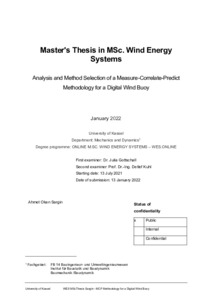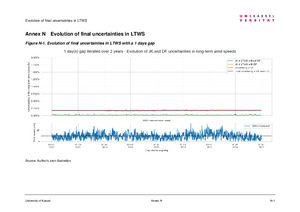Analysis and Method Selection of a Measure-Correlate-Predict Methodology for a Digital Wind Buoy
| dc.date.accessioned | 2024-04-15T12:53:02Z | |
| dc.date.available | 2024-04-15T12:53:02Z | |
| dc.date.issued | 2022 | |
| dc.identifier | doi:10.17170/kobra-202403269870 | |
| dc.identifier.uri | http://hdl.handle.net/123456789/15667 | |
| dc.language.iso | eng | |
| dc.rights | Namensnennung 4.0 International | * |
| dc.rights.uri | http://creativecommons.org/licenses/by/4.0/ | * |
| dc.subject.ddc | 624 | |
| dc.title | Analysis and Method Selection of a Measure-Correlate-Predict Methodology for a Digital Wind Buoy | eng |
| dc.type | Masterarbeit | |
| dcterms.abstract | The determination of the site-specific wind conditions has a significant influence on the development and use of offshore wind energy. Lower uncertainties of wind potential result in cost-effective project financing. Floating lidar systems (FLS) or wind lidar buoys have become increasingly common in recent years as a measuring technology for the determination of offshore wind resource. However, due to harsh offshore environmental conditions, offshore measurements with FLS are prone to reliability issues which might result in lower data availabilities than required by industry guidelines. FLS are hard to reach during winter times in high wind periods with higher wave heights. It is not an exception that several months of FLS data would not be available for an MCP process. Motivated by this purpose, this work used a measure-correlate-predict (MCP) method to determine whether an interim step of gap-filling was required as part of a long-term correction procedure. With an hourly temporal resolution, the performance of a data filling algorithm with omnidirectional linear least squares was analyzed in depth. KPIs including MBE, MAE, and RMSE of mean wind speeds throughout concurrent periods were summarized from the investigation of deviations introduced by incremental sliding gaps of 1-day to 60-days gap scenarios. The model performance was assessed both for the training (SelfDF) and validation (ValDF) periods. The long-term wind speeds were derived for each iteration with and without a data-filling algorithm. Between the SelfDF and ValDF root mean square error of mean wind speed, a strong negative association was identified for all gap scenarios. This novel relationship (ISPE method) was used to determine the uncertainties in data-filling. The jackknife algorithm was deployed to assess the uncertainties in the long-term correction of both scenarios. One of the study's main questions was whether a short-term data filling phase was required before applying the long-term correction. Both scenarios showed identical long-term wind speed predictions negating this requirement for the considered MCP method. This was primarily due to the omnidirectional regression parameters and the reduced impact of the proportion of gaps on the model fit. The study reaffirmed the industry recommendation of 80% minimum availability for measurement campaign data as a reliable threshold since the mean deviation during 60-day gap periods was not more than 0.3% throughout the investigated iterations. | eng |
| dcterms.accessRights | open access | |
| dcterms.creator | Sargin, Ahmet Okan | |
| dcterms.extent | xiv, 110, A1-N1 Seiten | |
| dc.contributor.corporatename | Kassel, Universität Kassel. Fachbereich Bauingenieur- und Umweltingenieurwesen | |
| dc.contributor.referee | Gottschall, Julia (Dr.) | |
| dc.contributor.referee | Kuhl, Detlef (Prof. Dr.-Ing.) | |
| dc.subject.swd | Boje | ger |
| dc.subject.swd | Windenergie | ger |
| dc.subject.swd | Messung | ger |
| dc.type.version | publishedVersion | |
| kup.iskup | false |
Dateien zu dieser Ressource
Das Dokument erscheint in:
-
Masterarbeiten [1]
















